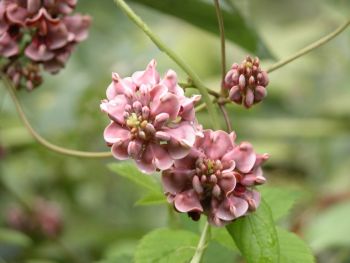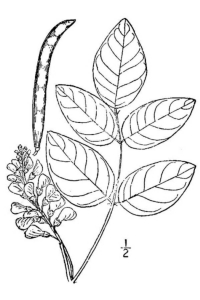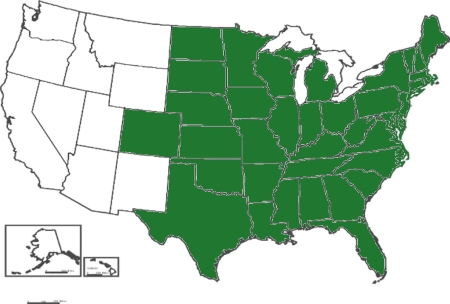Apios americana
 |
 |
Photo courtesy Renee Brecht |
Britton & Brown |
| Botanical name: | Apios americana Medik |
| Common name: | ground nut |
| Synonomy: | Apios americana Medik.
var. turrigera Fern. Glycine apios L. |
| Group: | dicot |
| Family: | Fabaceae |
| Growth type: | Vine/Forb/herb |
| Duration: | perennial |
| Origin: | native |
| Plant height: | to 10'' |
| Foliage: | Once pinnately-compound leaves with 5 to 7 leaflets; pods 2-4" in length. |
| Flower: | Dark red, 1/2" |
| Flowering time: | Flowers early July to late August; fruits early September, probably into October |
| Habitat: | swamps and moist thickets |
| Range in New Jersey: | statewide |
| Heritage ranking, if any: | n/a |
| Distribution: |  |
| Misc. | USDA
lists as FACW, usually occurs in wetlands (estimated probability
67%-99%), but occasionally found in non-wetlands. Many people are familiar with the edibilty of this plant. Its underground stems have swellings called "groundnuts" that are edible. Early explorers and colonists depended upon groundnut as a food source. Colonists on Roanoke Island, later known as the "Lost Colony", sent samples to Queen Elizabeth. We know from writings of Captain John Smith that it was eaten in Jamestown in 1607. It was also eaten by the Pilgrims of Plymouth Massachusetts. According to Ed Klekowski, Professor, Biology Department, University of Massachusetts Amherst, "Groundnut was so important to the colonists of the Connecticut River valley that in 1654, the town of Southampton passed a law that prohibited Amerindians from digging groundnut on "English-Lands." The first offense was punishable by a period in the stocks; for the second offense, the culprit was whipped!" Henry David Thoreau also enjoyed groundnut, preferring it better when it was boiled than roasted. For more information on the ethnobotany of groundnut visit Professor Klekowski of University of Massachusett Amerherst's page on groundnut. Apios,Greek word meaning pear; referring to the shape of the tubers; americana, American. |